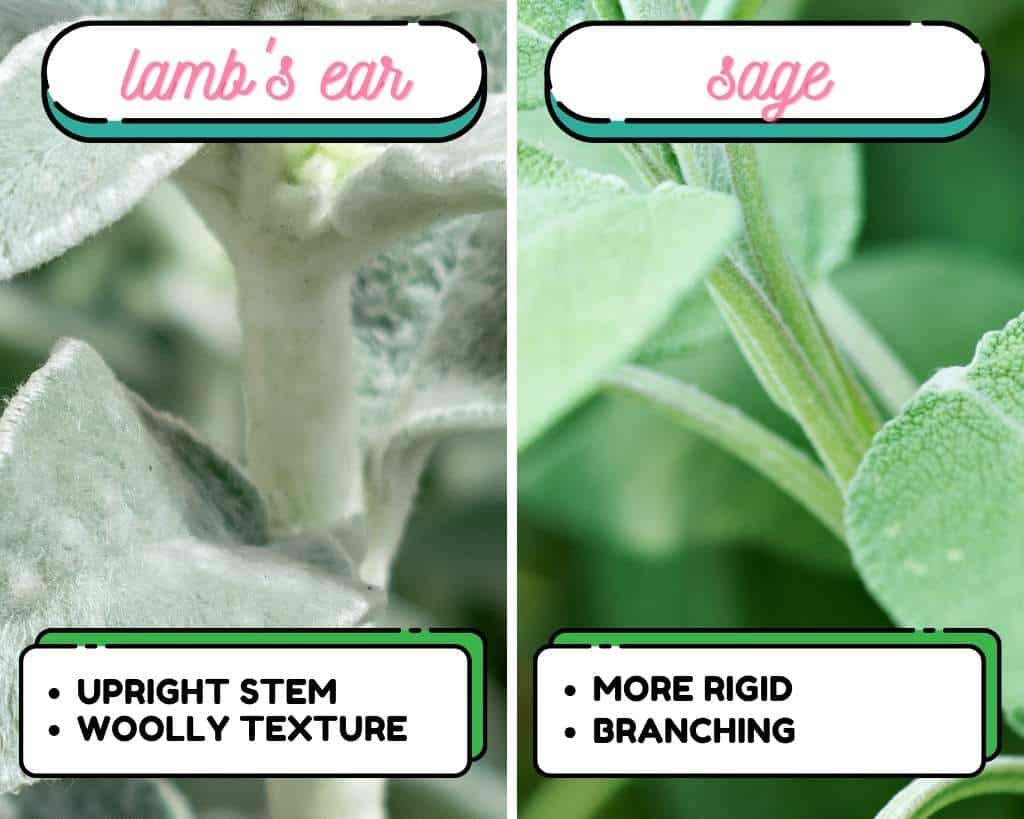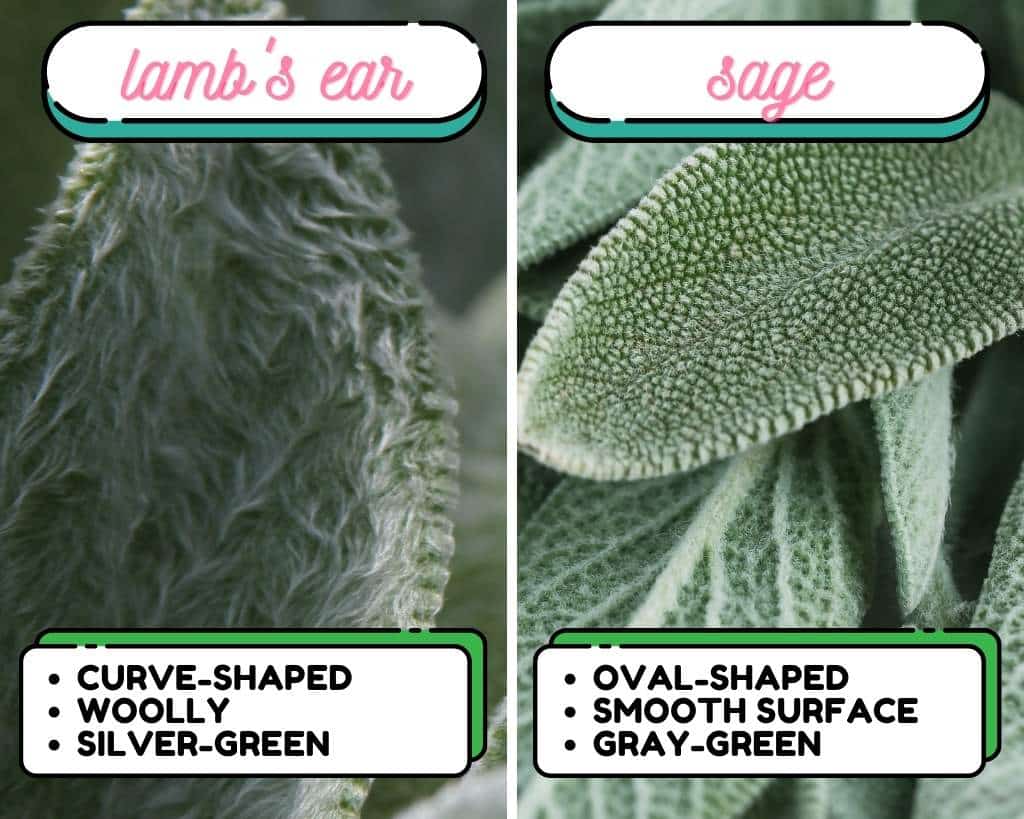Lamb’s Ear and sage are two popular plants used for various purposes, including medicinal, culinary, and ornamental. Lamb’s Ear is a soft-textured plant with fuzzy leaves that resemble the ears of a lamb, while sage is an aromatic herb with a distinct flavor. Both plants have unique characteristics that make them stand out in their way.
In this article, we will compare these perennial plants based on their features, uses, and benefits. We will explore the differences between these two plants to help you understand which one might best suit your needs.
| Lamb’s Ear | Sage | |
| Name | Stachys byzantina | Salvia officinalis |
| Zones | 4-9 | 5-9 |
| Height | 1-2 feet | 1-2 feet |
| Width | 1-2 feet | 2-3 feet |
| Sunlight | Full sun to partial shade | Full Sunlight |
| Soil | Well-Drained | Well-Drained |
| Lifespan | Perennial | Perennial |
| Origin | Middle-East | Mediterranean |
| Family | Lamiaceae | Lamiaceae |
| Propagation | Seeds, Division | Seeds, Cuttings |
| Diseases | powdery mildew and rust | powdery mildew, root rot |
| Pests | slugs and snails | aphids, spider mites, or whiteflies |
Lamb’s Ear vs Sage – Key Differences & Similarities

Now, let’s fully explore the key points of “Lamb’s Ear vs Sage,” where we will discuss the essential characteristics of the two plants and find out their similarities and differences.
Plant Size
There are some differences and similarities when comparing the plant size between Lamb’s Ear and Sage.
Both plants reach up to a similar height of 1-2 feet. The width of Lamb’s Ear plants can vary depending on their maturity and growing conditions. Generally, a mature Lamb’s Ear plant can spread about 1 to 2 feet (30 to 60 centimeters).
On the other hand, Sage typically has a broader and bushier growth habit than Lamb’s Ear. The width of Sage plants can range from 2 to 3 feet (60 to 90 centimeters) or even more expansive, depending on the specific variety and growing conditions.
Stems

Lamb’s Ear stems are relatively soft and non-woody. They are herbaceous and covered with dense hair, giving them a fuzzy texture.
In contrast, Sage stems are woody and more rigid in structure. They are characterized by sturdy, upright growth and branching.
Leaves – color, shape, size, and texture

Lamb’s Ear leaves are mainly known for their furry leaves that resemble the ears of a Lamb. The attractive leaves of the lamb’s Ear are elongated and oblong with rounded edges.
The color of the Lamb’s Ear leaves a soft, silvery-gray hue, which gives them a striking appearance in the garden. The leaves grow in a basal rosette form, forming dense clumps near the ground.
Sage leaves, on the other hand, have their distinctive qualities. They are typically smaller and narrower than Lamb’s Ear leaves, with an oval or lanceolate shape. The color of the Sage leaves is gray-green, lending an earthy tone to the foliage.
The surface of the leaves is smooth and textured, with a slightly wrinkled or crinkled appearance. Sage leaves grow opposite each other along the stems, forming a dense arrangement.
Regarding similarities, both Lamb’s Ear and Sage leaves offer a touch of gray coloration, albeit with different shades.
Flowers

Lamb’s Ear produces small, tubular, purple flowers typically clustered in dense spikes. The color of Lamb’s Ear flowers can vary depending on the specific variety. Still, they are commonly seen in pale purple, pink, or lavender shades.
The individual flowers are tiny and densely packed, creating a visually appealing inflorescence. The texture of the flowers is delicate and soft to the touch, adding to the overall tactile experience.
Sage flowers are known for their showy and vibrant appearance. They form tall, upright spikes adorned with multiple whorls of small, tubular flowers.
Sage flowers come in various colors, including purple, blue, white, and pink. The individual flowers are larger than those of Lamb’s Ear and have a distinct two-lipped shape.
The texture of Sage flowers is smooth, and the petals can feel velvety or slightly fuzzy.
The similarities between the flowers of Lamb’s Ear and Sage lie in their tubular shape and clustered growth pattern. Both plants produce flowers in elongated spikes, with individual blossoms having a tubular form.
Both the flowers are known to attract pollinators such as bees and butterflies.
Growing Conditions
Soil
Lamb’s Ear and Sage have specific soil requirements for optimal growth and health in the garden. Lamb’s Ear thrives in well-draining soil with moderate fertility and good moisture retention. It adapts well to various soil types.
Sage prefers well-drained soil with a pH level between 6.0 and 7.0. Both plants benefit from slightly acidic to neutral soil. Consistent moisture and mulching help maintain their health. Provide the right soil conditions for healthy growth and longevity of Lamb’s Ear and Sage.
When considering Lamb’s Ear vs Sage regarding soil requirement, Sage can tolerate a broader range of soil types than Lamb’s Ear.
Light
Lamb’s Ear prefers full sun but can tolerate some shade, while Sage thrives in full sun. Both plants need at least six hours of direct sunlight daily for optimal growth.
In hot climates, partial shade during the hottest day helps prevent stress. Adequate sunlight promotes vigorous growth, flower production, and overall vitality for Lamb’s Ear and Sage.
Also Read: Lamb’s Ear vs Mullein: Which is Better for Your Garden?
Temperature and Humidity
Lamb’s Ear can tolerate a wide temperature range, from approximately 60 to 80 degrees Fahrenheit (15 to 27 degrees Celsius). Providing shade and mulching in hot summers and proper care in colder regions helps maintain its resilience.
Sage thrives in temperatures ranging from approximately 60 to 90 degrees Fahrenheit (15 to 32 degrees Celsius), with some shade recommended during intense heat.
Both plants are relatively adaptable to humidity variations but require sufficient air circulation to prevent fungal diseases.
Watering and Irrigation
Lamb’s Ear and Sage prefer well-drained soil and should be carefully watered to avoid overwatering. Overly wet soil can cause root rot and other issues. Allow the soil to dry slightly between waterings.
Lamb’s Ear is relatively drought-tolerant, preferring moderate moisture levels. Sage can survive prolonged periods of drought and benefits from deep watering when the top inch of soil feels dry. Apply mulch to retain moisture and regulate soil temperature, reducing watering frequency.
Fertilization and Nutrients
Lamb’s Ear is a low-maintenance plant that thrives in moderately fertile soil. Adding compost before planting provides adequate nutrients.
Avoid excessive fertilization to prevent excessive foliage growth over flowers. A light application of slow-release fertilizer in spring supports development.
Sage, on the other hand, benefits from slightly higher soil nutrient content. Incorporate compost or aged manure before planting for improved fertility. Apply organic fertilizer in early spring and midsummer for growth and flower production.
Both plants benefit from annual compost dressing for overall health. Monitor soil nutrient levels and adjust fertilization accordingly.
Pests and Disease Management
Lamb’s Ear is resistant to pests but may encounter fungal diseases in humid conditions. Provide adequate spacing and ventilation, avoid overhead watering, and remove affected leaves to prevent fungal spread.
Sage is also resistant to pests but may attract aphids, spider mites, or mealybugs. Monitor and take prompt action. Avoid powdery mildew by ensuring spacing and air circulation and avoiding overhead watering.
Also Read: Lamb’s Ear vs Dusty Miller: A Comparison of Two Popular Garden Plants
Propagation and Spacing
Lamb’s Ear can be propagated through division or seed sowing. Divide mature clumps in spring or fall, ensuring each section has roots and foliage.
Sow seeds indoors in late winter or the garden after the last frost. Keep seeds moist until germination, which takes about two weeks.
Sage can also be propagated through division or seed sowing. Divide established plants in spring or fall, ensuring each section has roots and shoots. Sow seeds indoors in late winter or the garden after the last frost. Germination takes about two to three weeks.
Both plants need proper spacing for airflow and growth. Lamb’s Ear requires 12-18 inches (30-45 cm) between plants, while Sage needs 18-24 inches (45-60 cm).
Lamb’s Ear vs Sage: Uses and Benefits
Lamb’s Ear is primarily grown for its ornamental value, adding visual interest and texture to gardens. It also has traditional medicinal uses. The leaves of Lamb’s Ear can be used as a bandage to stop blood flow. Although, some parts of the plant are not edible.
On the other hand, Sage is a versatile herb widely used in culinary applications for its distinct flavor. It has medicinal properties and can be utilized in various forms for its aromatic qualities.
Sage is also known for its anti-fungal and anti-biotic properties. Its tea is widely popular for healing different ailments.



